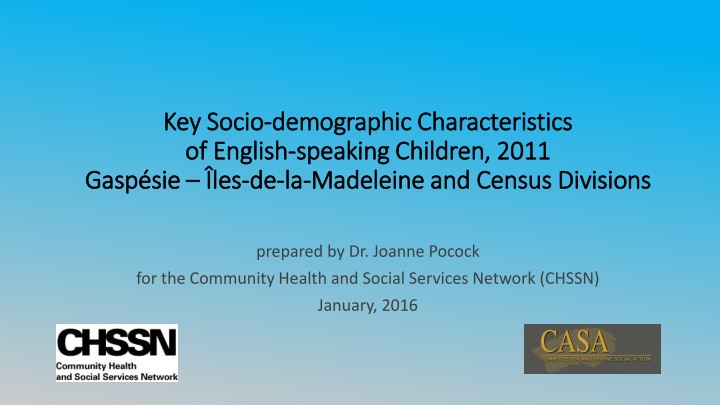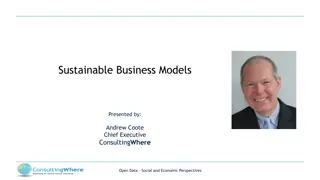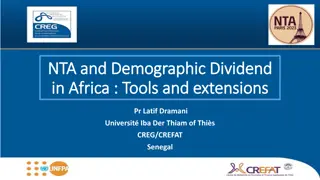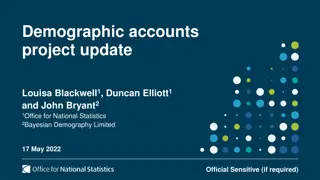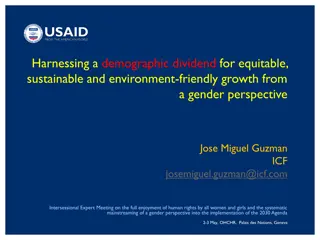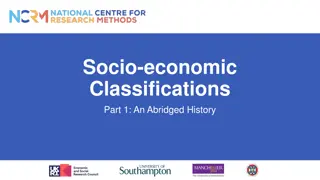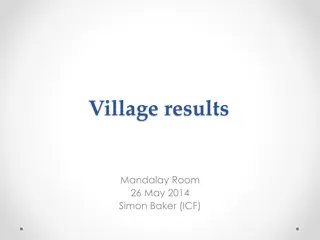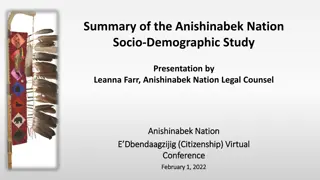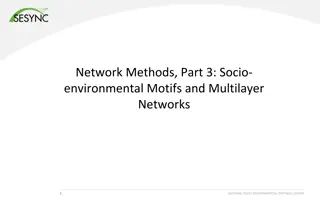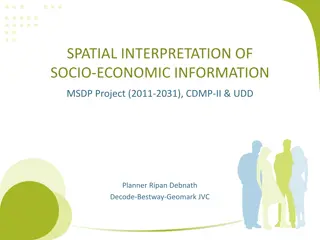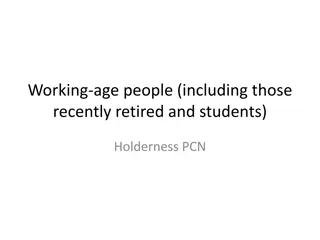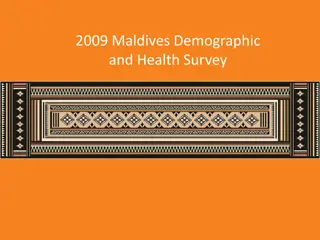Key Socio Key Socio- -demographic Characteristics demographic Characteristics of English of English- -speaking Children, 2011 speaking Children, 2011 Gaspésie ésie
This study focuses on the socio-demographic profile of English-speaking children in Gaspésie–Îles-de-la-Madeleine and Census Divisions in 2011. It provides insights into the demographic characteristics of this specific group within the mentioned regions.
Download Presentation

Please find below an Image/Link to download the presentation.
The content on the website is provided AS IS for your information and personal use only. It may not be sold, licensed, or shared on other websites without obtaining consent from the author.If you encounter any issues during the download, it is possible that the publisher has removed the file from their server.
You are allowed to download the files provided on this website for personal or commercial use, subject to the condition that they are used lawfully. All files are the property of their respective owners.
The content on the website is provided AS IS for your information and personal use only. It may not be sold, licensed, or shared on other websites without obtaining consent from the author.
E N D
Presentation Transcript
Key Socio Key Socio- -demographic Characteristics demographic Characteristics of English of English- -speaking Children, 2011 speaking Children, 2011 Gasp sie sie les les- -de de- -la la- -Madeleine and Madeleine and Census Gasp Census Divisions Divisions prepared by Dr. Joanne Pocock for the Community Health and Social Services Network (CHSSN) January, 2016
About this document Characteristics This document consists of a series of graphs which illustrate key socio-demographic characteristics of the 0-5 year cohort in the English-speaking and French- speaking populations across the Gasp sie les-de-la-Madeleine region. Information is also presented on the socio-economic characteristics of the population aged 25-44 who comprise the bulk of the parent group of these children. Population proportion Household living arrangements - Living in a lone-parent family Socio-economic status Low educational status Unemployment Low income Living below LICO
Methodological notes and definitions Data is from the 2011 National Household Survey (Statistics Canada) Data is not shown for smaller population counts. The symbol - is used when data has been suppressed. It does not signify 0, but rather a low population count for a given characteristic. The Aboriginal population figures prominently in the FOLS-English population of Avignon and should be considered carefully. The language concept is First Official Language Spoken which is derived from the census questions on knowledge of official languages, mother tongue and home language. The Minority-Majority Index (mmi) compares the value of the English-speaking minority with that of the French-speaking majority with whom it shares a territory. The low-income cut-off (LICO) is a measure based on the share of family income spend on food, shelter and clothing. Persons living below LICO are understood to be living in straitened circumstances .
Age Structure of the English- and French-speaking Populations Gasp sie - Iles-de-la-Madeleine and its Census Divisions, 2011 English Speakers French Speakers Geography 0 to 14 years 15 to 24 years 25 to 44 years 45 to 64 years 65 years and over 0 to 14 years 15 to 24 years 25 to 44 years 45 to 64 years 65 years and over Total Total Les les-de-la-Madeleine 630 70 100 155 200 105 11,905 1,515 1,290 2,490 4,520 2,090 Le Rocher-Perc 1,355 125 155 170 545 360 16,475 1,965 1,610 3,150 6,230 3,515 La C te-de-Gasp 1,630 190 115 380 545 385 15,890 2,155 1,720 3,370 5,900 2,735 Bonaventure 2,645 420 325 595 665 630 14,895 1,725 1,560 2,815 5,650 3,135 Avignon Gasp sie - Iles-de-la-Madeleine Quebec 3,110 9,405 1,046,495 730 1,535 158,640 145,520 316,405 287,860 138,065 425 1,120 780 2,080 815 2,770 365 1,845 11,670 82,515 6,618,170 1,630 10,420 1,074,695 828,165 1,706,705 2,039,415 1,255 8,530 2,330 16,475 4,310 31,095 2,135 15,960 969,195 Geography percentages percentages Les les-de-la-Madeleine Le Rocher-Perc La C te-de-Gasp Bonaventure Avignon Gasp sie - Iles-de-la-Madeleine Quebec Source: JPocock Research Consulting, based on data from the 2011 National Household Survey, Statistics Canada. Language concept is First Official Language Spoken with multiple responses distributed equally. 100.0% 100.0% 100.0% 100.0% 100.0% 100.0% 100.0% 11.1% 9.2% 11.7% 15.9% 23.5% 16.3% 15.2% 15.9% 11.4% 7.1% 12.3% 13.7% 11.9% 13.9% 24.6% 12.5% 23.3% 22.5% 25.1% 22.1% 30.2% 31.7% 40.2% 33.4% 25.1% 26.2% 29.5% 27.5% 16.7% 26.6% 23.6% 23.8% 11.7% 19.6% 13.2% 100.0% 100.0% 100.0% 100.0% 100.0% 100.0% 100.0% 12.7% 11.9% 13.6% 11.6% 14.0% 12.6% 16.2% 10.8% 9.8% 10.8% 10.5% 10.8% 10.3% 12.5% 20.9% 19.1% 21.2% 18.9% 20.0% 20.0% 25.8% 38.0% 37.8% 37.1% 37.9% 36.9% 37.7% 30.8% 17.6% 21.3% 17.2% 21.0% 18.3% 19.3% 14.6%
Proportion of Children (0-5) in the English- and French-speaking Population Gasp sie - Iles-de-la-Madeleine and its Census Divisions, 2011 English Speakers French Speakers Geography Proportion of Children 0-5 Proportion of Children 0-5 Total 0 to 5 years Total 0 to 5 years Population Population Les les-de-la-Madeleine Le Rocher-Perc La C te-de-Gasp Bonaventure Avignon Gasp sie - Iles-de-la-Madeleine 630 1,355 1,630 2,645 3,110 9,405 - 70 70 150 330 620 - 11,905 16,475 15,890 14,895 11,670 82,515 500 740 915 670 655 4,080 4.2% 4.5% 5.8% 4.5% 5.6% 4.9% 5.2% 4.3% 5.7% 10.6% 6.6% Source: JPocock Research Consulting, based on data from the 2011 National Household Survey, Statistics Canada. Language concept is First Official Language Spoken with multiple responses distributed equally.
Low Socio-economic Vitality of Official-Language Minority Communities, by Economic Region, Canada, 2011 Composite OLMC population At a provincial level, Quebec s English-speakers display the second highest level of socio-economic vulnerability when aspects such as low education levels, unemployment and labour force participation and low income tendencies are analyzed. Region quintile 1 1 1 1 1 1 1 1 1 1 1 Source: Research Team, Official Languages Branch, Department of Canadian Heritage, based on data from the 2011 National Household Survey, Statistics Canada. Notes: The composite measure for the low socio-economic vitality aggregates the ranking of the individual low socio-economic vitality variables and measures for a given level of geography. The composite indicator permits us to observe whether a given community displays one of five levels of low socio-economic vitality relative to other official-language minorities in Canada, ranging from very low to very high. The minority-majority index (mmi) compares the value for the OLMC with that of the majority with whom it shares a territory. The Intergenerational Index measures the value for the 25-44 age group with that of the 45-64 age group. A value greater than 1.00 indicates that the characteristic is more common in younger adults (25- 44) than in older adults (45-64). The 9611 temporal index measures the change in the characteristic for the given minority-language community between 1996 and 2011. rank 66 65 64 63 62 61 60 59 58 57 56 Nord-du-Qu bec (QC) Gasp sie - Iles-de-la-Madeleine (QC) Interlake (MB) Abitibi - T miscamingue (QC) Campbellton - Miramichi (NB) C te-Nord (QC) Cariboo (BC) Estrie (QC) West Coast - Northern Peninsula - Labrador (NL) Cape Breton (NS) Hamilton - Niagara Peninsula (ON) 20,645 9,950 1,430 5,378 97,338 5,335 1,940 23,440 878 5,095 33,143 On a regional basis, very high levels of socio- economic vulnerability are observed in the English- speaking populations in Quebec s Gasp sie-Iles-de- la-Madeleine, Nord-du-Quebec*, Abitibi T miscamingue, Cote-Nord and Estrie regions. These five regions are ranked among the top ten economic regions (administrative regions in Quebec terms) with respect to the measure for low socio- economic vitality when all Official-language Minority Communities (OLMCs) across Canada are taken into consideration. *It should be noted that the majority of the population of Northern Quebec is of Aboriginal backgrounds.
Among Quebecs English speakers (15+), 9.4% are unemployed compared to 6.9% of French speakers. The regions with the greatest proportion of unemployed English speakers are Gasp sie-Iles-de-la- Madeleine (28.1%) and Cote-Nord (27.5%).
Provincially, the proportion of English-speaking children (0-5) (5.7%) is somewhat smaller than French-speaking (6.7%). In the Gasp sie-Iles-de-la- Madeleine region, the proportion of English-speaking children (0-5) outweighs the Francophone group (6.6% compared to 4.9%).
The proportion of children (0- 5) living in lone-parent families in the Gasp sie-Iles- de-la-Madeleine region slightly exceeds the provincial average for the total English language population. Among the census divisions, the proportion of English- speaking children (0-5) living in lone-parent families greatly exceeds the proportion in this living arrangement when all age groups are combined. Put simply, the 0-5 age group is highly likely to be in a lone- parent family compared to other age groups.
When English-speaking and French-speaking children (0-5) living in the Gasp sie-Iles de- la-Madeleine region are compared, English speakers are much more likely to be living in a lone-parent family.
Generally, the provincial averages for low educational attainment among Anglophones and Francophones aged 25-44 are similar. In the Gasp sie-Iles-de-la- Madeleine region, the proportion of English-speakers aged 25-44 with low education levels is substantially greater than among Francophones the same age. Le Rocher-Perc is the only census division where French speakers (25-44) with low levels of education outweigh English-speakers.
Among Quebecs 25-44 age group, the proportion of unemployed English speakers is greater than the proportion of unemployed French speakers. Within the Gasp sie-Iles de-la- Madeleine region, the proportion of unemployed English speakers (27.2%) in this age group greatly exceeds the proportion of unemployed French speakers (11.1%).
In 2011, Quebecs English speakers aged 25-44 were much more likely to be living on a low income compared to French speakers of the same age. (35.9% compared to 24.7%) In the Gasp sie-Iles de-la- Madeleine region, the difference between the two language populations of this age group and the tendency to be living on a low income is even greater.
Low income cut-offs (LICO) is a measure for poverty recommended by the Centre d tude sur la pauvret et l exclusion (CEPE). Provincially, there is a greater proportion of English speakers aged 25-44 living in poverty compared to Francophones of the same age. In the Gasp sie-de-la-Madeleine region, English-speakers 25-44 outweigh French speakers in the tendency to be living in poverty. At a more local level, the gap is greatest in the Bonaventure area.
Thank-you! www.chssn.org
